CONSTELLATION GUIDE
Last updated: 17 June 2001
CONSTELLATION GUIDE |
"GO TO"....CAPRICORN
In case the "Dolphin" and "Little Horse" did not fit the zoological bill....how about a "Sea Goat?"
From: sherrodc@ipa.net (Clay Sherrod)
Welcome to our seventeenth Constellation Guide, "GO TO CAPRICORN" of the series "GO TO GUIDES for the ETX and LX 90 Telescope Users." Far in the southern skies (high overhead for many of our regular readers hovering around the Earth's equator!) in the midst of the periphery of the watery "ocean" of the universe, just east of the great Milky Way's "celestial river" of the ancient Egyptian cultures is a wandering "Sea Goat" who represents one of the twelve constellations of the Zodiac.
Although most of us are familiar with the constellation name and its significance astrologically (there's an oxymoron for you), few have ventured into is expansive boundaries in search of celestial wonders. There is a good reason for that...
....there aren't any. Nowhere within the constellation will you find the likes of the Orion Nebula, the Andromeda Galaxy, the Pleiades, star clouds, Ring Nebulae, globular clusters. This is a constellation that is noticed by its absence of notable and, frankly "interesting" deep sky objects. So other than the one nice globular cluster Messier 30 in Capricorn, this installment of your Constellation "GO TO" TOURS will concentrate on observing the many (and there are, indeed MANY!) fine double and multiple stars within the brighter stars of this constellation.
IN ADDITION - there is a nice bonus and purpose for your visiting Capricorn: the distant planets URANUS and NEPTUNE are perched there for the next many years. Since these planet move VERY slowly against the background stars because of their extreme distance from our viewing station here on Earth, they will be in this constellation for many years. Check your AutoStar coordinates for weekly, monthly and yearly changes in position from those provided below (epoch June 10, 2001).
Note that this fairly inconspicuous constellation is in a relatively star-poor area of the sky sandwiched between the fabulous object-rich areas of Sagittarius (to its west) and an equally star-poor Aquarius to the east. Even the areas nearest the Celestial Equator are 10 degree south (-10 degrees declination) so ALL objects in Capricorn will have negative (-) declinations in the lists below.
The ECLIPTIC - this being the 10th of the Zodiacal constellations - passes right through the entire span E-W of Capricorn, so it is often than planets will visit its realm. As a matter of fact.....for the next few years, as stated you can enjoy TWO planets within Capricorn: URANUS and NEPTUNE, so I have included their June-July 2001 coordinates below as part of our "GO TO" TOUR! You will find some brief but practical information regarding observations of these planets below.
Also appearing in this installment is a quick "observing tips summary" for proper nomenclature, positioning and observing techniques for double stars. There are several stars noted here that will make excellent test objects for specific models of our GO TO telescopes, so make note of them if you have been wanting a challenging test for the overall optical performance of your telescope and eyepiece combinations.
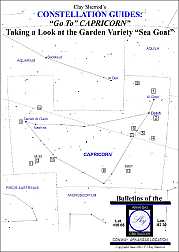
Each GO TO object is discussed for your telescope regarding the type of conditions necessary for you to view it optimally for discern the very faintest details....double star challenges for each size telescope .....magnifications and aperture necessary for most objects, and much, much more. This is YOUR complete GUIDE to get you on your way to exploring this large constellation. Although some interesting and "test" double stars as well as on nice variable star is included in the "GO TO" TOUR, there is a particularly wide range of very interesting double and multiple stars too numerous to list or mention here.
After our usual Concise List of objects with RA and DEC coordinates for your reference, there will be a complete and abbreviated listing of good double and multiple stars for most telescopes from 60mm to 200mm in size. In addition and for more information about these stars consult a good handbook, such as the "Burnham's Celestial Handbook," Vol. 1 for a very comprehensive list of locations, magnitudes and angular separations of these wonderful stars.
Use the attached star chart (above) and the following Guide as an excellent reference for your next star party itinerary, or a beginning for further study into the thousands of objects visible in this part of the sky. Truly these extensive Constellation Study Guides will most definitely put your AutoStar to work for you in the most efficient and enjoyable way possible! As a matter of fact, MANY AutoStar users are now programming their own "Tours" based on these guides, using each constellation as a separate GO TO Tour for the AutoStar library that can be added in or deleted through the main edit screen on your PC or MAC computer.
We hope you enjoy these comprehensive GUIDES to touring the constellations via your AutoStar and its computer-driven telescope. Each new installment is complete with diagrams, charts and illustrations that you will find nowhere else. Please let us hear YOUR feedback and your observations of each and every constellation after YOU have toured its vast reaches of our skies!
-----------------------------------
YOUR CAPRICORNUS CONCISE DIRECTORY OF INTERESTING OBJECTS -
There is a listing found at the end of our "concise list" of selected "best" objects that gives an abbreviated description, position, magnitude and size of each of the fine multiple stars found in Capricorn. I urge you to challenge yourself and equipment to seek out these stars....explore strange new worlds...go where no man...., (no, better stop there).
ALSO remember to "go to" both Uranus and Neptune as part of this tour, as described as your last two objects in this TOUR. Note that the coordinates for both planets will VERY gradually change from those given, but not by much. Your AutoStar has the wonderful capability of calculated the exact position for each day, hour and minute that you choose to observe these planets from ANY particular observing location.
For your specific "GO TO" TOUR I have chosen the finest 14 objects in Capricorn (and, boy, was it hard to find some!), mostly double stars...two deep sky objects and one variable star; as with all GUIDES, all objects listed below will be visible in all telescopes (some naked eye) from the ETX 60 through the LX 90; of course larger apertures may "show" an object a bit closer and "better," but frequently a wide field and low power view is more desirable than aperture.
NOTE: unlike deep sky objects, the many double stars listed here can actually be observed very well in lighted suburban skies, provided that your telescope can reach the magnitude specified for the faintest star of the group you are observing. Steady air is the most important aspect in good double star observing, NOT sky transparency (see http://www.weasner.com/etx/buyer-newuser-tips/seeing.html ) as is required for deep sky observing of faint, extended objects.
The very low altitude (-10 to -30 degrees declination) of Capricorn in our mid-to-late summer skies lends itself well to very good and long-period observing for ETX and LX 90 users in the most southern states of the U.S. and Europe, and ideally suited for observers between +20 degrees and -20 degrees. When rising about dark in the east in early summer, Capricorn will remain in the sky throughout the night, transiting the meridian at midnight about August 9. All objects and difficult double stars are ALWAYS best observed when they are located nearly overhead (or as high in the sky as possible), thus requiring the observer to look through the thinnest portion of the Earth's "lens" of atmosphere and haze.
As with all of the "GO TO" TOUR constellation lists, I recommend a good star atlas and/or chart which will list all the finest objects, constellation-by-constellation. One very handy reference guide is the PETERSON FIELD GUIDE TO THE STARS AND PLANETS, which features complete lists with declinations, right ascensions, magnitudes, and all pertinent information for you to expand your observing horizons beyond this brief GUIDE. For the computer, my favorite quick reference and very comprehensive descriptions of objects is by far the "deepsky2000" software available at: http://www.deepsky2000.net/ . Note that this very affordable software package ALSO allows very quick and accurate construction of "Go To" Autostar tours for these constellations as well as allows a very nice laptop control of any ETX or LX telescope!
Note that your AutoStar will NOT have every object listed on every constellation GO TO tour....this is intentional. You can access some of the most interesting objects of the sky directly from their coordinates. It is quite simple as you merely enter these coordinates as follows in the 10-step process:
1) Press the "MODE" key and hold down for 3 seconds and release;
2) Displayed will be the current Right Ascension and Declination of the center of field of view of where your telescope is presently pointed (assuming that you have properly aligned from "home position");
3) [NOTE: if you have the Meade electric focuser attached to any of the ETX or LX telescopes, holding down the "MODE" key will bring up the "Focus" command first....merely scroll (lower right scroll key) down one step to access the RA and DEC to enter your desired coordinates]
4) Press the "GO TO" button on AutoStar;
5) This will change the display and you will note the cursor blinking over the first digit of RIGHT ASCENSION (R.A.); merely use the number keys and dial in the R.A. of the object you are searching for;
6) When done, press "Enter;"
7) This moves the blinking cursor over the "DEC" coordinates;
8) [NOTE: the declination, unlike R.A., can be either positive or negative and you will see the "+" or "-" sign displayed depending on where your telescope is aimed at that time; if it is NOT the desired setting (plus or minus), merely use your arrow key to move the blinking cursor OVER the "+" or "-" sign and change by using either of your lower corner SCROLL KEYS;
9) Proceed to enter the DEC using number keys;
10) Press either "Enter" or "Go To" when finished and the telescope begins slewing to your desired object!!
The constellation tour Star Chart above (click on and save to a file on your PC; then open it and re-size to fit the page and print for a very handy at-the-scope star chart) will get you started on your journey for this constellation.
Following is the concise object list for your "GO TO" TOUR of Capricorn; NOTE: most of these double stars listed, and those particularly in the abbreviated list following are NOT listed among your AutoStar library for "STARS / DOUBLE". For these you MUST enter the coordinates of RA and DEC for them and let Autostar find the positions for you. To do this, merely press down and HOLD the "Mode" key for about three seconds; scroll down to the display showing your RA and DEC for the current position in which your telescope is oriented;
For others, you may wish to find some of the objects from the AutoStar Library (for example, you can easily go to "Messier 30" if you pull up "Object/Deep Sky/Messier Object/..type in '30'...." and then press "Enter", followed by "GO TO" to access my favorite beautiful galactic cluster. On the other hand, if you want to experiment and become a "better AutoStar user" try entering the exact R.A. and DEC coordinates of that object as described above after holding down the MODE key. You will find the accuracy of entered GO TO's to be somewhat less than those stored in AutoStar, but the capability of acquiring unlisted objects is fantastic!
FOR PLANETS (Uranus and Neptune in this case), go to "SELECT /OBJECT/SOLAR SYSTEM...." and use your lower left scroll key to move until finding each planet by name; press "ENTER", let it calculate its position for you, then "GO TO" at which time the telescope will take off and center the tiny - BUT VISIBLE - planets for you for the EXACT date you are out, no matter when you use this TOUR!
OBJECT 1:
your Capricorn index stars (2) - Al Giedi (alpha Cap) - R.A. 20h 15' / DEC (-)12 40 - Magnitude: 4.5, 3.8
OBJECT 2:
nice triple star! - Dabih (beta Capricorni) - R.A. 20h 18' / DEC (-)14 56 - Magnitudes: 3.0 & 6.0 & 10
OBJECT 3
history! - Deneb Al Giedi - R.A. 21h 44' / DEC (-)16 21 - Magnitude: 2.8 - Where Neptune was discovered
OBJECT 4:
another double star - Sigma Cap. - R.A. 20h 17' / DEC (-)19 17 - Magnitudes: 5.5 & 10, wide nice double
OBJECT 5:
great double star! - Pi Capricorni - R.A. 20h 25' / DEC (-)18 22 - Magnitudes: 5 & 8.5 - wide, pretty!
OBJECT 6:
tough LX 90 test double - Rho Cap - R.A.20h 26' / DEC (-)17 59 - Mags: 5 & 9 - only 0.5" separation!
OBJECT 7:
great double star! - Omicron Cap. - R.A. 20h 27' / DEC (-)18 45 - Magnitudes 6 & 6.5, great for ETX 60!
OBJECT 8:
ETX 90 test double - Burnham153 - R.A. 20h 44' / DEC (-)26 36 - Mags: 7 & 8 - 1.6" arc, great test!
OBJECT 9:
nice double - Burnham668 - R.A. 20h 30' / DEC (-)10 02 - Mags: 6 & 11 - close, nice in ETX 90 & above
OBJECT 10:
ETX 125 test double - Zeta Cap. - R.A. 21h 24' / DEC (-)22 38 - Mags: 4 & 13 - wide, but a challenge!
OBJECT 11:
double in nice view - 41 Cap. - R.A. 21h 39' / DEC (-)23 29 - Mags: 5.5 & 12 - great star for ETX 90 test!
OBJECT 12:
nice globular cluster!! - Messier 30 (ngc7099) - R.A. 21h 38' / DEC (-)23 25 - Mag. 8.4, nice, but small
OBJECT 13:
small galaxy - ngc6907 - R.A. 20h 22' / DEC (-)24 58 - Mag.12 , very faint, but visible in ETX 125, LX 90
OBJECT 14:
variable star - UU Cap - R.A. 21h 34' / DEC (-)14 06 - Mag. 8.7 to 11, semi regular, very interesting!
OBJECT 15:
URANUS - (use "Solar System" GO TO) - Mag: 5.7 / Size: 4.4" arc / Color: Blue Green
OBJECT 16:
NEPTUNE - (use "Solar System" GO TO) - Mag. 7.8 / Size: 2.2" arc / Color: Yellow-blue
OBJECTS 17 THROUGH 41 -MULTIPLE/DOUBLE STARS in Capricorn (other than those listed above)
listing of objects in order of RIGHT ASCENSION visible and resolvable in ETX and LX scopes:
NOTE: These doubles are NOT detailed in the following "Visual Guide" -use the abbreviated descriptions
ONLY stars of interest in 2.5" through 8" aperture telescopes are provided. Use the following standard
nomenclature for proper star label:
h = Herschel / B = Burnham / numbered star = Aiken ADS listing / E = Struve
STAR SYSTEM / R.A. and DEC. / type / magnitudes, directions & separations (" of arc) / SCOPE LIMIT
h156 - RA 20 04 / DEC -09 04 / triple, mags 7 (primary), 10 (east - 6.2"), 12 (NE - 8.4") - ETX 90
3 - RA 20 14 / DEC -12 30 / double, mags. 5.5, 13 (NNE - 27") - ETX 125+
E2683 - RA 20 26 / DEC -13 18 / double, mags 9, 9 (ENE - 23") - Good test for ETX 125
h2975 - RA 20 31 / DEC -22 24 / double, mags. 7.5 & 11 (N - 9.8") - excellent for ETX 90, ETX 125
h1537 - RA 20 34 / DEC -15 29 / double, mags. 8.5 & 8.5 (N - 3.3") - good ETX 60/70 test object! NICE
h40 - RA 20 41 / -19 40 / double, mags. 8.5 & 9 (NE - 5.2") - great test object for ETX 60/70!
B674 - RA 20 42 / -21 04 / double, mags. 8 & 10.5 (E - 1.6") - perfect test for ETX 90 and 125
h2998 - RA 20 46 / -20 48 / double, mags. 8.5 & 9 (ESE - 5.9") - possible in all scopes
h5226 - RA 20 47 / -27 33 / double, mags. 7 & 8.5 (E - 19") - good in ETX 60, very nice in ETX 90
h3003 - RA 20 50 / -23 58 / double, mags. 6 & 8 (S - 1.7") EXCELLENT for ETX 90 and larger!
B271 - RA 21 17 / -26 33 / triple, mags. 7 (primary), 9.5 (W - 3.2"), 12 (E - 82") - great object for ETX 125
B1262 - RA 21 20 / -15 07 / double, mags. 8.5 & 9 (ESE - 2.0") - great ETX 90 test star
B683 - RA 21 25 / -20 26 / double, mags. 8.5 & 11 (S - 2.9") - another good one for ETX 90
Aiken2096 - RA 21 31 / -16 25 / double, mags. 7 & 10.5 (NE - 0.8") - super test for LX 90!
B168 - RA 21 51 / -20 15 / double, mags. 8 & 9.5 (SE - 5.7" arc) - use high power in ETX 60 & 70!
h3071 - RA 2155 / -15 23 / double, mags. 7 & 11 (NW - 18") - great star for the ETX 90
....AND NOW ON WITH THE SHOW!! (refer to the Star Chart for all the objects described in detail on the "Guide")
---------------------------------
A VISUAL GUIDE TO OUR DEEP SKY OBJECTS IN CAPRICORN
Object 1 - Our Starting Star in Capricorn - "Al Giedi" (alpha Capricorni) - Also a COMPLEX MULTIPLE!!
For the record, this is known as the "goat star" from the Arabic in association with the odd association as a "sea goat" for this constellation. For a change, this is a REALLY interesting and nice starting point for our "GO TO" TOUR. Alpha Capricorni is NOT the brightest star in this constellation, that honor being taken by DELTA ("Deneb Al Giedi" discussed below). But this is no ordinary star. With a 6 arc' separation, Al Giedi (NOT "Deneb Al Giedi") is a wonderful double star for the ETX 60 and 70, with the brightest (alpha 2) being magnitude 3.5 and the other (alpha 1) being magnitude 4.2. Both stars are wonderful in a wide field ETX 60/70. Now, here is the good part: BOTH stars have companion stars as well! So this double is also a double (same scenario as the more brilliant and famous "double double" star in the constellation "Lyra" -
see http://www.weasner.com/etx/ref_guides/lyra.html ). Except in this case, the two brighter stars ARE not a physical pair, only an OPTICAL double, two stars appearing close but are really far apart in space. Alpha 2 is only 100 light years from us,while Alpha 1 is over 500 light years distant.
Alpha 1 and Alpha appear exactly 6' arc apart, with the fainter star being about due WEST of Alpha 2. Alpha 2 (brighter star) has a small companion star at 11th magnitude some 6.6" arc almost due SOUTH from the bright star, so it should be relatively easy to find (although faint) in the ETX 90. Alpha 1 (fainter star) actually has TWO companions: the first is magnitude 9, about 45" arc (the size of Jupiter in the same eyepiece) just WEST of SOUTH from the brighter star; due SOUTH of the brighter star is another companion at magnitude 13 the same distance exactly. Alpha 1's 9th magnitude companion is an easy target for the ETX 90, but the 13th magnitude star will required the ETX 125 and LX 90 for spotting. I have made up the following chart (oriented correctly for the ETX / LX scope with NORTH at top and EAST at right) to assist you in the proper orientation of these five stars.
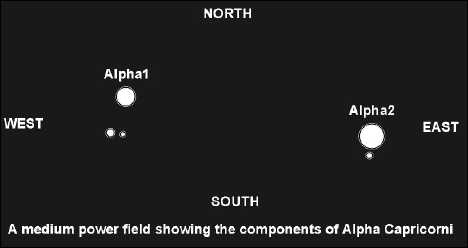
Object 2 - Beta Capricorni - Another Good Double - nice color contrast, great for a small telescope!
AT about the same distance as Alpha 2, above, Beta Capricorni ("Dabih") is 150 light years distant and given a visual magnitude of right at 3.0. The primary star is magnitude 3.0 and the secondary star is magnitude 6.1, about 3 arc minutes DUE WEST of the brighter star. This makes an easy object for ALL telescopes at fairly low power. However, the secondary star is ALSO a double, this having a faint 10th magnitude companion DUE EAST of it, ONLY 0.8" arc. This means that ONLY the LX 90 is capable of resolving this star, and then only on the very best nights; about 227x is required for clean separation. The small star will appear like a "knob" on the "right side" of the 6th magnitude star.
Object 3 - Delta Capricorni - "Deneb Al Giedi" - A Historical Marker in the Sky!
Delta Capricorni, a 2.8 magnitude star, is the brightest star in the constellation and is very close to Earth, only 50 light years distant. There is not much out of the ordinary about this star other than the fact that in 1846, the LAST planet that was discovered "off" American soil - Neptune - was found only 4 degrees northeast of this relatively bright star! What makes this even MORE interesting at the present time is that over 150 years later, Neptune is BACK VERY close to where it was originally found after its 165 year trip around the sun. So, you can see where history was made....and be part of history when Neptune returns to the place of its "conception" in 2010! (for observing Neptune, see the description following).
Object 4 - Sigma Capricorni - A Great Double Star for All Telescopes - A Challenge for the ETX 60-70!
Here is a nice example of a very "late" spectral type "K" double star; the primary star, Sigma Cap appears distinctly red at magnitude 4.1, and it has a 10th magnitude companion located almost exactly 1' arc DUE SOUTH (easy to find that way!) from it. If you can remember how "big" Jupiter looks in a medium power eyepiece (about 75x should do it), that is the space from the brighter star due south to the companion. This should be easy in the ETX 125 and LX 90, worth the effort in the ETX 90 but certainly attainable, and a challenge (because of the faintness of the secondary star) in the ETX 60 and 70.
Object 5 - A Wonderful Double Star for all Size Telescopes! - Pi Capricorni
This is a "classic" double star, and very bright at that. Overall, the two-star system combines for a magnitude of 5.1, with the brighter star ringing in at magnitude 5.2 and its companion at 8.5. Look for the fainter star (very easy in all scopes - use about 20x to 30x per inch aperture) only 3.2" arc away almost exactly SE from the main star. This is a very brilliant white-blue pair of stars. This is also Burnhams B60 on his famous double star list.
Object 6 - Rho Capricorni - A VERY Tough Triple, even for the LX 90 - Here is your test! ETX 125 bonus!
Maybe you can do it....maybe you can't. I can split this double star with 300x in my 6" Unitron refractor, but have not had the opportunity to attempt it with the LX 90. The ETX 125 will NOT even elongate this star on the best nights. Separation?? How about 0.5" arc?! That is a challenge. Rho Cap is a fifth magnitude star, easy to find through its coordinates. The companion star SHOULD be visible even in smaller instruments, at magnitude 9, but it is so close that it is nearly impossible to differentiate. HOWEVER, Rho gives us a BONUS star....a 13th magnitude true companion some 55" arc exactly SE of the brighter star. THAT one can be see with the ETX 125 on a very dark night when the constellation is highest in the sky.
Object 7 - Omicron Capricorni - Super Double for ALL Telescopes!
We have gotten one really tough double (but, we all like a challenge!) out of the way, so let's focus in on a really pretty and easy double star. Omicron Capricorni is a wonderful yellow, type-G double consisting of a 6th magnitude primary star with a 6.5 magnitude companion just south of WEST from the brighter star. Since the separation is a whopping 22" arc (half the size of Jupiter in the same eyepiece), even the ETX 60 and 70 should show this double with medium to medium-high magnification; in the ETX 90 and larger scopes, use very low power (the 26mm eyepiece is a good choice) to appreciate the real beauty of these two nearly equal brightness stars among a very star-poor background.
Object 8 - Another Double - A Great ETX 90 Star....one of S.W. Burnham's First: #B153
This is a super test star for the ETX 90. If you think your optical system is well collimated, cleaned and ready, scope out this one. B153 is a pair of 7.5 and 8.5 magnitude stars, very sun-typical. At only 1.6" arc separation this will make an ideal test for the 3.5" scope! Theoretically, the ETX 90 should knock a hole right in between these two stars....but sometimes life's tough. Use very high power to achieve a clean split between these two stars. Look for the fainter star DUE WEST of the brighter component. In the ETX 125 the stars will be cleanly split but very close together at 227x.
Objects 9 - A Very Nice Classic Double - Ideal for the ETX 90 and 125 - Burnham #668
B668 is a very nice test star for the ETX 90, wider in separation (a full 2.9" arc) but with a much fainter (11th magnitude) secondary star. The primary star is magnitude 6, so it will be clearly visible in the finderscope and easily identified in a low power field of view in all telescopes; higher magnification (about 175x and above) will be necessary to provide enough contrast with the 90 to see the faint star, which is NE of the primary. Look VERY close and attempt to block out the brighter star with a crosshair from a reticle eyepiece if possible! This is a relatively easy object in the ETX 125 and LX 90.
Object 10 - Zeta Capricorni - A Striking Double Star, a Test for the ETX 125 and LX 90
Here is a marked contrast in brightness, the primary star being 4th magnitude and the secondary ONLY 13th magnitude! Zeta Cap's components have shown NO change in position of the small star relative to the brighter one since its discovery as a variable. Due to its brightness, there is no mistaking the star, but move up in magnification to better than 200x in both the ETX 125 and LX 90 to actually "find" this faint star, which is nearly DUE NORTH of Zeta., but a full 21" arc - a good spacing - from the bright star; again, a crosshair blocking Zeta's light will GREATLY assist in your acquiring a view of the 13th magnitude companion.
Objects 11 - A Double Star With a View - 41 Capricorni - Wonderful Star for the ETX 90 and Larger Scopes
This wonderful double star makes quite a sight in a medium power eyepiece, with the globular cluster Messier 30 (see below) just WEST of this star; if you can find Messier 30, then you have found 41 Capricornus at a bright magnitude of 5.5, easily visible in the finderscope and low power eyepiece. The photograph below, Courtesy Lowell Observatory, shows the globular M-30 in relation to 41 Capricorni to its west (left)....note that in the ETX and LX scopes, the star will appear RIGHT of M-30, or a mirror image of this astronomically-oriented photograph.
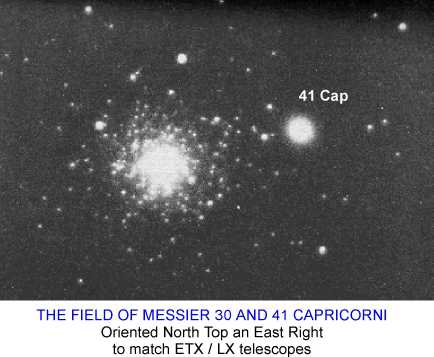
41 Capricorni is a 5.5 magnitude star of "medium" G-type spectrum. Very close (about 5.5" arc) to its SW is a 12th magnitude star, which should present a challenge in the ETX 90, right at the visual limit of that scope. The star should be seen steadily in the ETX 125 on a dark night, and relatively easy with the 8" scope.
Object 12 - Globular Cluster Messier 30 (while you're in the neighborhood!)
Finally! A Deep Sky Object in a seemingly vacuum of black space! This is the lone globular cluster that is accessible to visual telescopes in the entire large cluster of Capricorn! Nonetheless, it is an object worthy of observing! Messier 30 is rated at magnitude 8.4 visually but brighter photographically at nearly 6.2. M-30 is best known for its "star strings," seeming lines of stars that emanate from the central part of the globular. Speaking of the center, this one has one of the most tightly condensed central cores of all globulars, a feature clearly seen even with the ETX 90 which will NOT be able to resolve even the peripheral parts into individual stars; some faint stars will be glimpsed on very dark nights with the ETX 125 and a few more with the LX 90 with powers of about 150x. In all telescopes this relatively small globular will appear as an oval (not circular) glow, only about 4' long by 3' arc wide, with a very concentrated central brightness. This central core actually measures nearly 2' arc, almost disk-like. In the same field of view, using a wide angle eyepiece in all scopes, you will see the double star 41 Capricorni due east of M-30 (see photo above).
Object 13 - A Lone Galaxy Amidst a Sea of Blackness - ngc6907
This is a very small and faint (magnitude 11.8) galaxy that MAY be visible on a very dark night in the ETX 125 and can be glimpsed routinely with the LX 90. It measures only a small 2.5' x 2' in diameter and is a typical spiral galaxy (although NO detail is visible to the eye even in the largest telescopes). Fittingly, this isolated galaxy is located in one of the most "star-poor" regions of the summer sky, far in the southwestern "corner" of Capricorn.
Object 14 - Our "GO TO" TOUR Variable Star - UU Capricorni
Go to the American Association of Variable Star Observer's (AAVSO) wonderful web site for all the free star charts for serious variable star observing that you can possibly download! For UU Capricorni, only a "d" (medium-high, small scale and faint comparison star) chart is available at: http://charts.aavso.org/CAP/Y_CAP/YCAP-D.GIF . Merely download this chart to file, pull up and resize to fit your paper and print for a wonderful comparison chart at the telescope.
UU Capricorni is a great mid-range variable, semi-regular in its light fluctuations. That means that sudden and unexpected light changes can occur in a very short time frame, so constant observation of this star is always needed to "fill in the blanks." It varies in brightness from magnitude 8.7 to almost 11, making it an ideal star to watch for the ETX 90 and larger telescopes all the way through its 100-day cycle. This is a very red star (can be see as such at brightest) and a late "K" spectral type.
Object 15 - THE PLANET URANUS -
Since the planet Uranus will be located in the constellation of Capricorn until 2003, this will be included as a "GO TO" object; consult your Autostar for slight daily changes in its positions as it creeks slowly eastward through the Capricorni stars. In 2003, the planet will progress eastward and enter the boundaries of Aquarius, to the east where it will remain until 2009.
Uranus has rested in the "sea goat's" territory now since 1996. Now at a distance of 1.811 billion miles from Earth, look for Uranus as a blue-green nicely defined disk in the ETX 90 and larger telescopes, at magnitude 5.8, easily definable in the finderscope. With a small disk diameter of only 3.6" arc at the present time, don't expect to see very much here.
Uranus was discovered by Sir William Herschel, and documented as a new planet from its motion against the background stars in Taurus; as the years progress, J.E. Bode confirmed Herschel's discovery as he tracked Uranus through Taurus and on into Gemini (the bottom foot in the ancient 1784 engraving seen below). Note that on August 1, Bode had sketched Uranus due north of the right foot of one of the Gemini twins! Chart reproduced courtesy Archives of the Arkansas Sky Observatory.
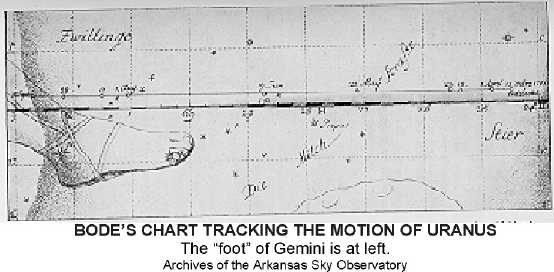
The ETX 125 and LX 90 will show an occasional belt or "stripe" across the planet, similar to the gaseous cloud patterns seen on Jupiter (see http://www.weasner.com/etx/buyer-newuser-tips/planets-jupiter.html ) as shown in the drawing below.
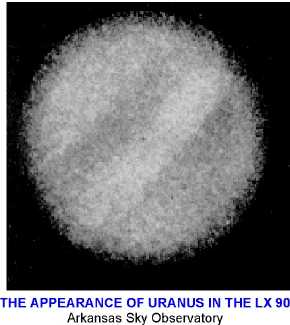
In all telescopes, including the ETX 60 and 70, this distant planet will demonstrate a tiny disk, clearly distinguishable from the stars, that is bluish in color; the two main equatorial belts (see drawing above) will appear slightly lighter than the rest of the globe. There ARE occasionally white cloud spots visible in scopes such as the LX 90 that can be followed and timed to accurately determine its rotational rates which are close to providing a "day" on Uranus of about 10 hours 49 minutes. However, while in Capricorn for the next few years, note that the E-W axis of Uranus will be up and down and the poles oriented left and right as clearly demonstrated in the beautiful color-enhanced Hubble Space Telescope photograph (courtesy NASA) shown below. Note also the rings which encicle the equatorial plane of the gaseous planet.
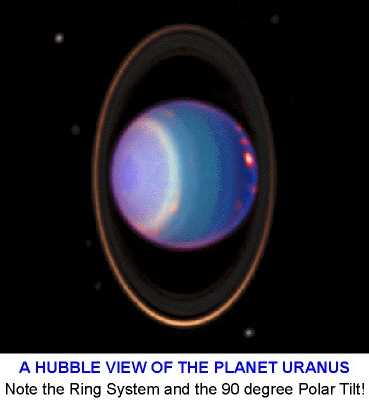
The ETX 125 might be able to spot three of the four major Uranian satellites (Ariel - mag. 13.7 / Titania - mag. 13.7 / and Oberon - mag. 13.8) The LX 90 will be challenged to pick up a fourth - "Umbriel" at magnitude 14.2; all will be see very close to the planet and as "stars" just on the limit of visibility. The following sketch by Herschel in February 1787, some time after the planet's discovery, shows the two brightest of these satellites.
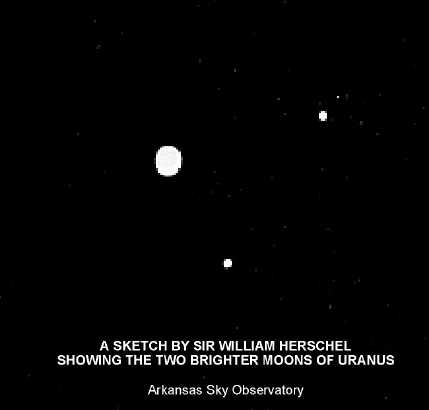
Object 16 - THE PLANET NEPTUNE -
As mentioned, the planet Neptune was actually discovered here in Capricron on September 25, 1856, almost 150 years ago. Since its orbital period around the sun is 165 years, Nepturne is again re-entering the place of its discovery to mankind. Like Uranus, this tiny planet (disk is only 2.3" arc!) appears very bluish in the telescope at high power which is needed to differentiate it from surrounding faint stars. It is magnitude 7.9 presently and will be in Capricorn much longer this decade than will be Uranus. Use your Autostar planetary library to compute its daily eastward path through the constellation. Little or no detail can be expected on this distant planet at its incredible distance of 2.73 billion miles from Earth. Look carefully at the NASA photography of Neptune taken with the Hubble Space Telescope (HST) and note the conspicuous darker feature that is very much like the Great Red Spot on Jupiter and the many bright white upper level clouds visible.
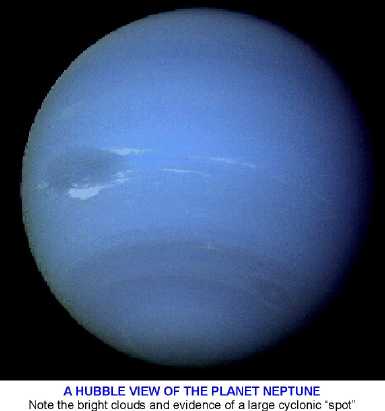
----------------------------------------
WANDERING ABOUT....YOUR NEW "USER OBJECT" IN CAPRICORN
This is an unusual entry for our AutoStar User Object library: we are going to enter a "Historical Marker," the position at which Sir William Herschel discovered the planet Uranus on March 13, 1781 with a "7-foot" (focal length) telescope, thinking that his discovery was at first a bright and condensed COMET! Since it was found only 4 degrees NE of Deneb Al Geidi, this is a spot that will be interesting to all of your visitors at the next star party! Curiously I find myself looking at this spot often, noting that it is the LAST place that a human being "found" a planet visually. I look at those stars repeated to humble myself, remembering that 220 some years before me, one of the greatest astronomers who will ever live was peering at those SAME stars, yet there was an unexpected interloper among the....the planet Uranus. And I sigh and reflect....
On AutoStar, go to: "Select/Object [enter]...." scroll down to "User Object" [ enter]. Now enter the coordinates given above for "Deneb Al Giedi", using the number keys on AutoStar. After entering the coordinates and pressing "Enter" yet again, scroll down one and you can list the magnitude of the object as "7"[Enter]. Now go back and enter the NAME of this User object merely as: "History."
Next Constellation GO TO" TOUR Installment: AQUARIUS, the "Water-Bearer," the eleventh "sign of the Zodiac. Unlike Capricorn, Aquarius is PACKED full of wonderful deep sky objects, some nice doubles and variables, and it will really keep you moving in that GO TO mode of your revolutionary computerized telescope....what do YOU think Herschel would have thought about that machine?
Good Observing and explorations of this wonderful world of deep space!
P. Clay Sherrod
Arkansas Sky Observatory
Conway / Petit Jean Mountain
Arkansas
Return to the top of this page.
Go back to the Observational Guides & References page.
Go back to my ETX Home Page.